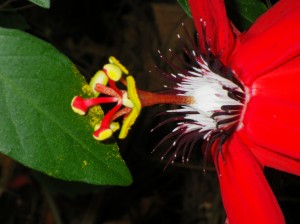 The new routines are starting to set in. We go to breakfast in the dining hall, on the other side of the suspension bridge, a short, 5 minute walk across the well-tended grounds of the La Selva Biological Station. It is a short walk with a specific purpose, from the house to the hall and then back across the bridge, making a left on the trail, and heading around the clearing to the old lab where my new office is. Birds call from within the trees, fleeting blurs of movement and color, the scarlet streak of the red-rumped tanager; the yellow shimmer of an unidentified little warbler; the iridescent flash of a hummingbird.
The new routines are starting to set in. We go to breakfast in the dining hall, on the other side of the suspension bridge, a short, 5 minute walk across the well-tended grounds of the La Selva Biological Station. It is a short walk with a specific purpose, from the house to the hall and then back across the bridge, making a left on the trail, and heading around the clearing to the old lab where my new office is. Birds call from within the trees, fleeting blurs of movement and color, the scarlet streak of the red-rumped tanager; the yellow shimmer of an unidentified little warbler; the iridescent flash of a hummingbird.
But the little walks are also characterized by changing smells, bits of biology and physics mixed together in small, tropical olfactory puzzles. The collared peccaries that nonchalantly roam the grounds of the field station looking for fruits, seeds, insects and just about anything else edible, smell like a bad case of BO. It is their normal, distinctive smell, the one that makes you think “the piggies are somewhere close” well before you see them. In areas where they are hunted, they flee at the sound or sight of humans, leaving behind a powerful trail of stink that lingers well after the crashing sounds of their escape fade away.
Then there are those hard to describe smells of certain plants, whiffs that hit you as you walk by and make you pause, digging into your memory for a trace of recognition. They smell somewhat familiar, a little disgusting, vulgar even, almost recognizable but elusive. You walk on, looking around, sniffing the air like an ancestral creature, nose up in the air, resentful of your meager human olfactory resources, wishing to have the nose of a hound or a pig. Many plants carry smells well beyond the scent (or stink) of their flowers. There are flowers that smell like rotting flesh, attracting flies and other decaying-tissue feeders, tricking them into a spate of pollination and perhaps frustration for the visiting insect. Other flowers, like orchids, range in scents from the pleasurable to the disgusting, all geared towards attracting a certain species of insect or other creature, for which the smell is a powerful incentive to visit.
The forest is filled with smells and scents, perfumes and fragrances. Some are accidental and rather purposeless, like the smell of wet soil and leaf litter, musty, earthy and pleasant; others redolent of old times, childhoods spent hiking and camping in the tropics experiencing for the first time the independence of home and parents; the miasma of a small swampy spot, its stagnant water thick with algae, rotting vegetation and bacteria. We trek through this forested stage somewhat as aliens (perhaps returning aliens) long detached from the essential skills for survival in this environment, filled with puzzling atavistic memories, fears and instincts kicking-in in surprising ways. It is yet another way to connect to our roots, to the environments that nurtured us and gave us food, medicine and shelter. I only wish I had a Smell Camera, so these essential pieces of the forest could be recorded and shared like we do photographs. For the time being, I’ll have my nose, my memories and my words to record and share the scents of the tropical forest.
Carlos

Recent Comments